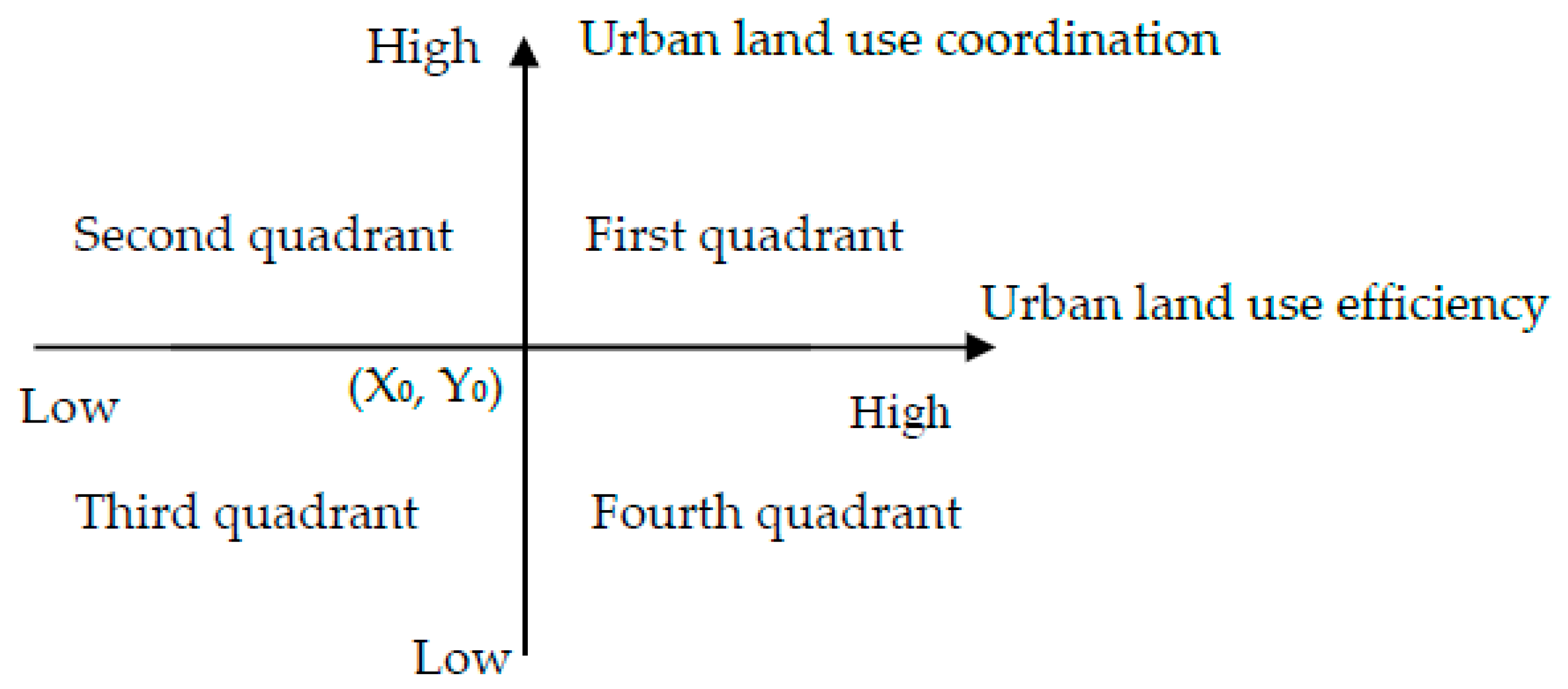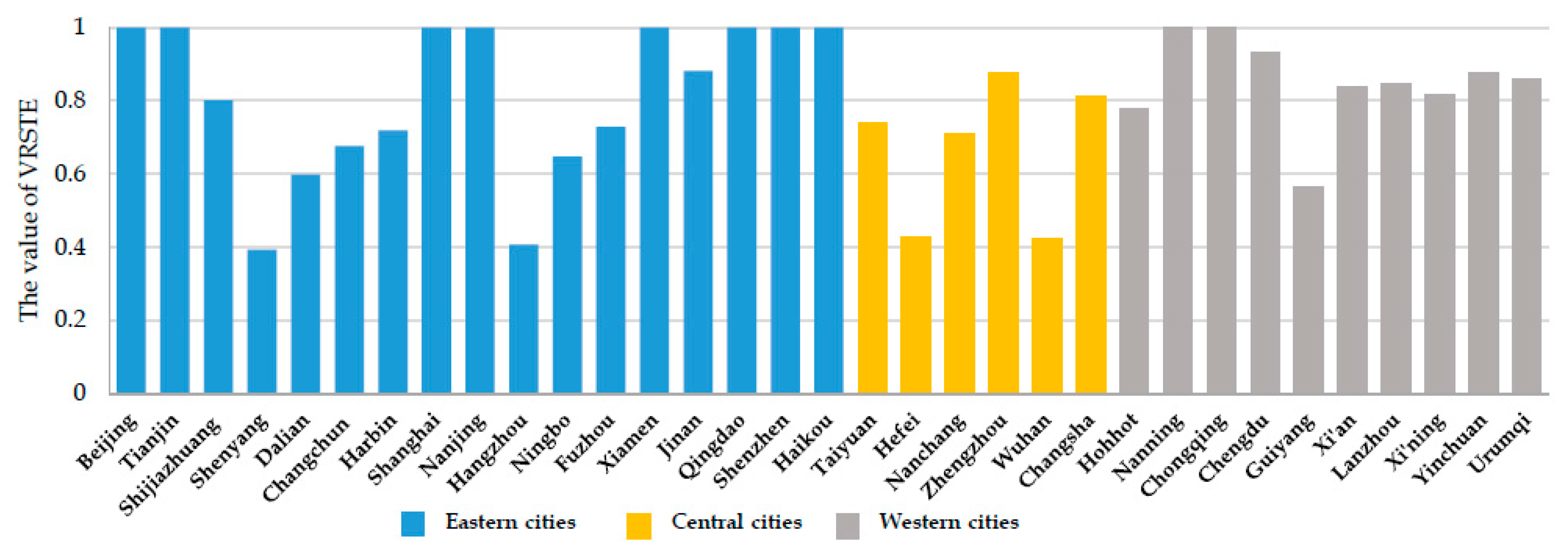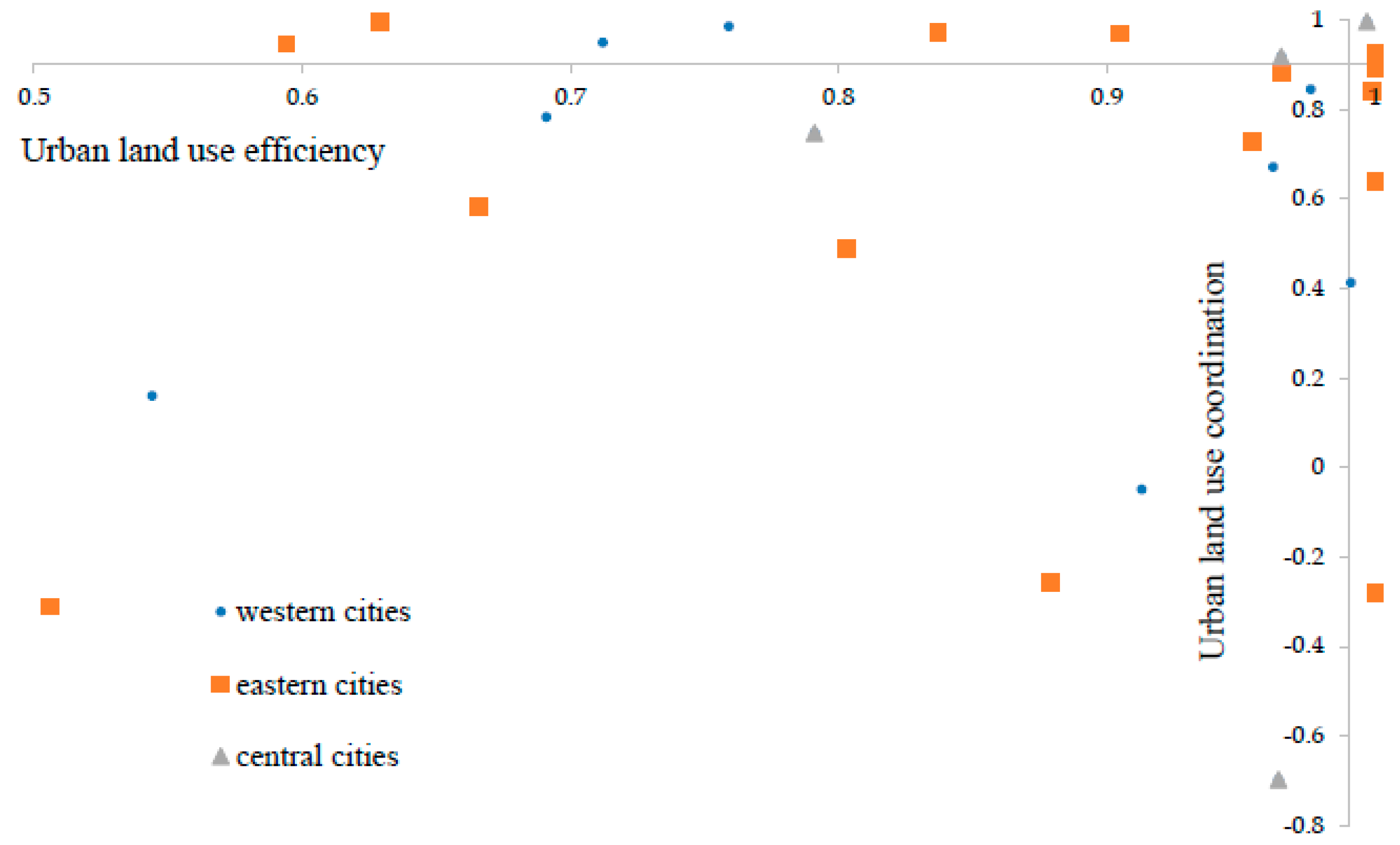Urban Land Use Efficiency and Coordination in China
Abstract
:1. Introduction
2. Materials and Methods
2.1. Evaluation System
2.2. Evaluation of Urban Land Use Efficiency
2.3. Evaluation of Urban Land Use Coordination
2.4. Evaluation Coordinate System of Urban Land Use Efficiency and Coordination
2.5. Sample Selection
3. Results
3.1. Urban Land Use Efficiency in China
3.2. The Degree of Urban Land Use Coordination in China
3.3. Urban Land Use Efficiency and Coordination in China
4. Discussion and Conclusions
Acknowledgments
Author Contributions
Conflicts of Interest
References
- López, E.; Bocco, G.; Mendoza, M.; Duhau, E. Predicting land-cover and land-use change in the urban fringe: A case in Morelia city, Mexico. Landsc. Urban Plan. 2001, 55, 271–285. [Google Scholar] [CrossRef]
- Waddell, P. UrbanSim: Modeling urban development for land use, transportation, and environmental planning. J. Am. Plan. Assoc. 2002, 68, 297–314. [Google Scholar] [CrossRef]
- Saba, R.S.; Abdolrassoul, S.M.; Seyed, M.M.; Ali, A.A. Sustainability through uncertainty management in urban land suitability assessment. Environ. Eng. Sci. 2013, 30, 170–178. [Google Scholar]
- Choy, L.H.T.; Lai, Y.; Lok, W. Economic performance of industrial development on collective land in the urbanization process in China: Empirical evidence from Shenzhen. Habitat Int. 2013, 40, 184–193. [Google Scholar] [CrossRef]
- Chen, R.; Ye, C.; Cai, Y. The impact of rural out-migration on land use transition in China: Past, present and trend. Land Use Policy 2014, 40, 101–110. [Google Scholar] [CrossRef]
- Jean-Marie, H.; Szymon, M.; Erwin, K. The adaptive efficiency of land use planning measured by the control of urban sprawl. The cases of the Netherlands, Belgium and Poland. Land Use Policy 2012, 29, 887–898. [Google Scholar]
- Southavilay, B.; Teruaki, N.; Shigeyoshi, T.; Tetsuo, S. Land use change and its determinant factors in northern Laos: Spatial and socio-economic analysis. J. Agric. Sci. 2012, 4, 190–204. [Google Scholar]
- Jin, S.; Jayne, T.S. Land rental markets in Kenya: Implications for efficiency, equity, household income, and poverty. Land Econ. 2013, 89, 246–271. [Google Scholar] [CrossRef]
- Janine, M.U.; Julian, F.Q. How to combine tradition and modernity? Regulating customary land management in Ghana. Land Use Policy 2008, 25, 198–213. [Google Scholar]
- Thomas, G.J.; Mitsuru, S.; Dennis, L.E. Developing county-level commodity-flow models incorporating land-use characteristics and economic factors for Utah. J. Urban Plan. Dev. 2012, 138, 35–42. [Google Scholar]
- Ruben, N.L.; Andrew, J.P.; Robert, N.S. What drives land-use change in the United States? A national analysis of landowner decisions. Land Econ. 2008, 84, 529–550. [Google Scholar]
- Mason, G. The role of land markets in economic crises. Am. J. Econ. Sociol. 2009, 68, 854–888. [Google Scholar]
- Bardo, J.W.; Hartman, J.J. Urban Sociology: A Systematic Introduction; F.E. Peacock: Itasca, IL, USA, 1982. [Google Scholar]
- Chapin, F.S.; Kaiser, E.J. Urban Land Use Planning; University of Illinois Press: Champaign, IL, USA, 1970. [Google Scholar]
- Macedo, J. Urban land policy and new land tenure paradigms: Legitimacy vs. legality in Brazilian cities. Land Use Policy 2008, 25, 259–270. [Google Scholar] [CrossRef]
- Kironde, J. Land policy options for urban Tanzania. Land Use Policy 1997, 14, 99–117. [Google Scholar] [CrossRef]
- Terry, V.D.; Raoul, B. Laws, people and land use: A sociological perspective on the relation between laws and land use. Eur. Plan. Stud. 2009, 17, 1797–1815. [Google Scholar]
- Jessica, I. From squatter to settler: Applying the lessons of nineteenth century U.S. public land policy to twenty-first century land struggles in Brazil. Ecol. Law Quart. 2011, 38, 179–232. [Google Scholar]
- Pauleit, S.; Ennos, R.; Golding, Y. Modeling the environmental impacts of urban land use and land cover change—A study in Merseyside, UK. Landsc. Urban Plan. 2005, 71, 295–310. [Google Scholar] [CrossRef]
- Mouri, G.; Aisaki, N. Using land-use management policies to reduce the environmental impacts of livestock farming. Ecol. Complex. 2015, 22, 169–177. [Google Scholar] [CrossRef]
- Mirzaei, M.; Solgi, E.; Salmanmahiny, A. Assessment of impacts of land use changes on surface water using L-THIA model (case study: Zayandehrud river basin). Environ. Monit. Assess. 2016, 188, 690. [Google Scholar] [CrossRef] [PubMed]
- Lin, G.; Ho, S.P. China’s land resources and land-use change: Insights from the 1996 land survey. Land Use Policy 2003, 20, 87–107. [Google Scholar] [CrossRef]
- Sanjiv, K.; Venkatesh, M. Characterizing long-yerm land use/cover change in the United States from 1850 to 2000 using a nonlinear Bi-analytical Model. R. Swed. Acad. Sci. 2013, 42, 285–297. [Google Scholar]
- Azam, H.; Bahman, J.A.; Jan, A.; Nicola, F.; Kaneyuki, N. Assessing the impacts of four land use types on the water quality of wetlands in Japan. Water Resour. Manag. 2013, 27, 2217–2229. [Google Scholar]
- Byungil, K.; Hyounkyu, L.; Hyungbae, P.; Hyoungkwan, K. Estimation of greenhouse gas emissions from land-use changes due to road construction in the republic of Korea. J. Constr. Eng. Manag. 2013, 139, 339–346. [Google Scholar]
- Irwin, E.G.; Bockstael, N.E. Land use externalities, open space preservation, and urban sprawl. Reg. Sci. Urban Econ. 2004, 34, 705–725. [Google Scholar] [CrossRef]
- Pouriyeh, A.; Khorasani, N.; Lotfi, F.H. Efficiency evaluation of urban development in Yazd City, Central Iran using data envelopment analysis. Environ. Monit. Assess. 2016, 188, 618. [Google Scholar] [CrossRef] [PubMed]
- Herold, M.; Couclelis, H.; Clarke, K.C. The role of spatial metrics in the analysis and modeling of urban land use change. Comput. Environ. Urban 2005, 29, 369–399. [Google Scholar] [CrossRef]
- Aguilera, F.; Valenzuela, L.M.; Botequilha-Leitão, A. Landscape metrics in the analysis of urban land use patterns: A case study in a Spanish metropolitan area. Landsc. Urban Plan. 2011, 99, 226–238. [Google Scholar] [CrossRef]
- Herold, M.; Scepan, J.; Clarke, K.C. The use of remote sensing and landscape metrics to describe structures and changes in urban land uses. Environ. Plan. A 2002, 34, 1443–1458. [Google Scholar] [CrossRef]
- Glaeser, E.L.; Kahn, M.E. Sprawl and urban growth. In Handbook of Regional and Urban Economics; Elsevier: Amsterdam, The Netherlands, 2003; pp. 2481–2527. [Google Scholar]
- Peiser, R.B. Density and urban sprawl. Land Econ. 1989, 65, 193–204. [Google Scholar] [CrossRef]
- Fang, X. The index system and method study of land use efficiency measurement. Syst. Eng. 2004, 22, 22–26. (In Chinese) [Google Scholar]
- Wang, H.; Wang, L.; Su, F.; Tao, R. Rural residential properties in China: Land use patterns, efficiency and prospects for reform. Habitat Int. 2012, 36, 201–209. [Google Scholar] [CrossRef]
- Xie, H.; Wang, W. Spatiotemporal differences and convergence of urban industrial land use efficiency for China’s major economic zones. J. Geogr. Sci. 2015, 25, 1183–1198. [Google Scholar] [CrossRef]
- Chia-Nung, L.; Tsung-Yu, L. An empirical analysis of links between transport and land use. Transport 2013, 166, 105–112. [Google Scholar]
- Feiock, R.C.; Stream, C. Environmental protection versus economic development: A false trade-off? Public Admin. Rev. 2001, 61, 313–321. [Google Scholar] [CrossRef]
- Yang, S. A study on the forecast and regulation of coordinated development of urban environment and economy in Guangzhou. Chin. Geogr. Sci. 1995, 5, 248–256. (In Chinese) [Google Scholar] [CrossRef]
- Zitti, M. Long-term urban growth and land use efficiency in Southern Europe: Implications for sustainable land management. Sustainability 2015, 7, 3359–3385. [Google Scholar] [CrossRef]
- Wang, Y.; Zhou, L.H. Assessment of the coordination ability of sustainable social-ecological systems development based on a set pair analysis: A case study in Yanchi county, China. Sustainability 2016, 8, 733. [Google Scholar] [CrossRef]
- Xie, H.; Wang, W. Exploring the spatial-temporal disparities of urban land use economic efficiency in China and its influencing factors under environmental constraints based on a sequential slacks-based model. Sustainability 2015, 7, 10171–10190. [Google Scholar] [CrossRef]
- Gong, S.Y. Study on the coupled coordination degrees between urban land intensive use system and social economic development: A case of Shandong province. Adv. Mater. Res. 2013, 731, 4827–4830. [Google Scholar] [CrossRef]
- Ding, S. Comprehensive Study on Urban Land Use Efficiency and Coordination. Master’s Thesis, Harbin Institute of Technology, Harbin, China, 2011. [Google Scholar]
- Deng, Q.H.; Zhu, J. Chongqing’s Economic Development and Its Cultivation of Sub-Regional Centers. J. Chongqing Univ. 2006, 12, 6–12. (In Chinese) [Google Scholar]
- Hong, D.Y. A higher level of social progress leads the new economic development. Seeking 2016, 7, 52–54. [Google Scholar]
- Sakieh, Y.; Salmanmahiny, A.; Jafarnezhad, J. Evaluating the strategy of decentralized urban land-use planning in a developing region. Land Use Policy 2015, 48, 534–551. [Google Scholar] [CrossRef]
- Long, H.L.; Liu, Y.Q.; Li, T.T. Spatial Interlinking of Land Use Planning and Environmental Protection Planning from the Perspective of Ecological Civilization Construction. Econ. Geogr. 2014, 34, 1–8. (In Chinese) [Google Scholar]
- Zhang, K.; Wen, Z. Review and challenges of policies of environmental protection and sustainable development in China. J. Environ. Manag. 2008, 88, 1249–1261. [Google Scholar] [CrossRef] [PubMed]




| Input Indicators | Output Indicators |
|---|---|
| Land area | Gross Regional Product |
| Total year-end population | Engel coefficient |
| Total fixed assets investment | Municipal districts end urban road area |
| Number of kindergartens and ordinary schools (including primary schools, middle schools, colleges and universities) | |
| Green coverage within built-up area |
| Category | Indicator Name | Unit |
|---|---|---|
| Economic | Regional GDP | Billion RMB/km2 |
| Regional total fixed assets investment | Billion RMB/km2 | |
| Regional general budget revenue | Billion RMB/km2 | |
| Society | Engel coefficient | - |
| The number of regional kindergartens and ordinary schools | Units/km2 | |
| The number of regional public libraries | Units/km2 | |
| The number of regional health institutions | Units/km2 | |
| Environment | Sewage treatment rate | % |
| Life garbage treatment rate | % | |
| Comprehensive utilization rate of industrial solid waste | % | |
| Green coverage of built-up area | % |
| City | Firm | CRSTE | VRSTE | Scale | |
|---|---|---|---|---|---|
| Beijing | 1 | 0.629 | 1 | 0.629 | drs |
| Tianjin | 2 | 0.506 | 1 | 0.506 | drs |
| Shijiazhuang | 3 | 0.534 | 0.802 | 0.666 | drs |
| Taiyuan | 4 | 0.739 | 0.741 | 0.997 | drs |
| Hohhot | 5 | 0.592 | 0.78 | 0.759 | irs |
| Shenyang | 6 | 0.393 | 0.394 | 0.999 | drs |
| Dalian | 7 | 0.571 | 0.598 | 0.954 | drs |
| Changchun | 8 | 0.611 | 0.676 | 0.905 | drs |
| Harbin | 9 | 0.602 | 0.719 | 0.837 | drs |
| Shanghai | 10 | 1 | 1 | 1 | - |
| Nanjing | 11 | 0.594 | 1 | 0.594 | drs |
| Hangzhou | 12 | 0.394 | 0.408 | 0.965 | drs |
| Ningbo | 13 | 0.548 | 0.648 | 0.846 | drs |
| Hefei | 14 | 0.413 | 0.428 | 0.965 | drs |
| Fuzhou | 15 | 0.585 | 0.729 | 0.803 | drs |
| Xiamen | 16 | 1 | 1 | 1 | - |
| Nanchang | 17 | 0.616 | 0.709 | 0.869 | drs |
| Jinan | 18 | 0.776 | 0.882 | 0.879 | drs |
| Qingdao | 19 | 0.699 | 1 | 0.699 | drs |
| Zhengzhou | 20 | 0.576 | 0.878 | 0.656 | drs |
| Wuhan | 21 | 0.411 | 0.426 | 0.964 | drs |
| Changsha | 22 | 0.642 | 0.812 | 0.791 | drs |
| Shenzhen | 23 | 1 | 1 | 1 | - |
| Nanning | 24 | 0.819 | 1 | 0.819 | drs |
| Haikou | 25 | 1 | 1 | 1 | - |
| Chongqing | 26 | 0.691 | 1 | 0.691 | drs |
| Chengdu | 27 | 0.507 | 0.933 | 0.544 | drs |
| Guiyang | 28 | 0.551 | 0.565 | 0.976 | drs |
| Xi’an | 29 | 0.555 | 0.837 | 0.664 | drs |
| Lanzhou | 30 | 0.815 | 0.847 | 0.962 | drs |
| Xi’ning | 31 | 0.745 | 0.816 | 0.913 | irs |
| Yinchuan | 32 | 0.624 | 0.877 | 0.712 | irs |
| Urumqi | 33 | 0.851 | 0.859 | 0.991 | irs |
| Component | Initial Eigenvalues | Extraction Sums of Squared Loadings | ||||
|---|---|---|---|---|---|---|
| Total | Variance Contribution | Cumulative Variance Contribution | Total | Variance Contribution | Cumulative Variance Contribution | |
| 1 | 2.702 | 90.075 | 90.075 | 2.702 | 90.075 | 90.075 |
| 2 | 0.245 | 8.156 | 98.230 | - | - | - |
| 3 | 0.053 | 1.770 | 100.000 | - | - | - |
| Component | Initial Eigenvalues | Extraction Sums of Squared Loadings | ||||
|---|---|---|---|---|---|---|
| Total | Variance Contribution | Cumulative Variance Contribution | Total | Variance Contribution | Cumulative Variance Contribution | |
| 1 | 3.602 | 40.021 | 40.021 | 3.602 | 40.021 | 40.021 |
| 2 | 1.342 | 14.911 | 54.932 | 1.342 | 14.911 | 54.932 |
| 3 | 1.260 | 13.995 | 68.927 | 1.260 | 13.995 | 68.927 |
| 4 | 1.021 | 11.349 | 80.277 | 1.021 | 11.349 | 80.277 |
| 5 | 0.686 | 7.620 | 87.897 | - | - | - |
| 6 | 0.624 | 6.934 | 94.831 | - | - | - |
| 7 | 0.315 | 3.504 | 98.334 | - | - | - |
| 8 | 0.085 | 0.946 | 99.281 | - | - | - |
| 9 | 0.065 | 0.719 | 100.000 | - | - | - |
| City | G (2014) | City | G (2014) |
|---|---|---|---|
| Taiyuan | 0.996 | Shanghai | 0.639 |
| Beijing | 0.994 | Shijiazhuang | 0.582 |
| Hohhot | 0.986 | Fuzhou | 0.490 |
| Harbin | 0.971 | Urumqi | 0.413 |
| Changchun | 0.969 | Chengdu | 0.160 |
| Yinchuan | 0.949 | Xi’ning | −0.049 |
| Nanjing | 0.945 | Jinan | −0.256 |
| Shenzhen | 0.925 | Haikou | −0.279 |
| Hefei | 0.918 | Tianjin | −0.310 |
| Xiamen | 0.891 | Wuhan | −0.697 |
| Hangzhou | 0.881 | Xi’an | −1.179 |
| Guiyang | 0.845 | Nanchang | −1.417 |
| Shenyang | 0.840 | Qingdao | −2.752 |
| Chongqing | 0.783 | Zhengzhou | −10.718 |
| Changsha | 0.748 | Naning | −13.653 |
| Dalian | 0.729 | Ningbo | −3740.488 |
| Lanzhou | 0.671 | - | - |
© 2017 by the authors. Licensee MDPI, Basel, Switzerland. This article is an open access article distributed under the terms and conditions of the Creative Commons Attribution (CC BY) license ( http://creativecommons.org/licenses/by/4.0/).
Share and Cite
Yang, X.; Wu, Y.; Dang, H. Urban Land Use Efficiency and Coordination in China. Sustainability 2017, 9, 410. https://doi.org/10.3390/su9030410
Yang X, Wu Y, Dang H. Urban Land Use Efficiency and Coordination in China. Sustainability. 2017; 9(3):410. https://doi.org/10.3390/su9030410
Chicago/Turabian StyleYang, Xiaodong, Yongxiang Wu, and Hang Dang. 2017. "Urban Land Use Efficiency and Coordination in China" Sustainability 9, no. 3: 410. https://doi.org/10.3390/su9030410
APA StyleYang, X., Wu, Y., & Dang, H. (2017). Urban Land Use Efficiency and Coordination in China. Sustainability, 9(3), 410. https://doi.org/10.3390/su9030410





